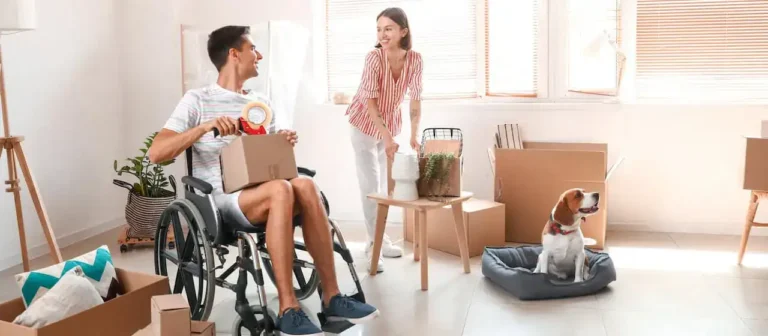Moving with a disability comes with some very unique challenges, but still ones that you can plan for.
For example, if muscle weakness, chronic pain, and other limitations make it more difficult to lift and carry your belongings, there are safer ways to get it done.
You should also think about accessibility in both your new home and the move itself. Make sure your new place has accessible appliances, proper lighting, and enough room for mobility aids. Similarly, for the relocation itself, you can arrange specialized transportation or stack boxes in a way that leaves plenty of space for a wheelchair, walker, or cane.
In short, careful planning and professional support can help you conquer these challenges. With the right strategies and resources, it’s possible to complete a move with as little stress as possible.
What We Cover in This Guide:
Meet the Experts

Keith Meadows, Executive Director at Disability Solutions

Emily Parker, Blog Writer at Goally

Mathew Cagney, CEO of ShiftCare

Alicia Trawtwein, Founder of The Mom Kind
Assess Accessibility Early

Thinking about accessibility in your new home early on can save you hours of frustration later. Keith Meadows, Executive Director at Disability Solutions, says:
“Small details can make the difference. For example, small steps or high thresholds at doorways can impede wheelchairs or walkers, poor lighting can complicate navigation or visibility, countertops might not be the right height, and switches or outlets might be out of reach.”
If you use a wheelchair, look for a living space with wide doors, accessible light switches, and door threshold ramps to ease the transition from 1 room to another. Make sure your new place has an outdoor ramp to make it easy to get in and out.
People with a wide range of disabilities can benefit from having accessible kitchens and bathrooms. In the kitchen, look for low counters and cabinets, pull-out shelves, a side-by-side refrigerator, and a stove with front controls. Common bathroom accessibility features include grab bars, walk-in showers, low sinks, and handheld showerheads.
You may also benefit from these features:
- Smart home technology: This type of tech helps you control your thermostat, appliances, and door locks from a mobile device.
- Raised beds and furniture: These furniture pieces make it easier to sit and lie down.
- Adjustable closet rods: Using these puts clothing and accessories within easy reach.
- Bright, even lighting: This type of lighting can improve visibility and help you see potential obstacles.
- Nonslip flooring: Reduces the risk of slips and falls.
Completing an Accessibility Audit
Before you move, walk through each area of your new home to determine if you’ll need to make modifications. Compare the home’s layout and features to your specific mobility, hearing, sensory, or vision needs. For example, if you have hearing loss, you might need to install a smoke detector that uses flashing strobes and/or vibrations to alert you to a fire.
Modifying Your New Living Space
Mathew Cagney, CEO of ShiftCare, advises people with disabilities to “complete accessibility modifications, like ramps or visual indicators, before moving in.” With permission from the property owner, you might be able to install a portable ramp, replace the doorknobs with lever-style handles, add a handheld showerhead, or set up a smart home system. Before the move is also a great time to install grab bars in the bathrooms and make sure there’s enough lighting in hallways and entryways.
Some modifications will have to wait until moving day or later, though. For example, you won’t be able to arrange your furniture until it’s off the truck and in your new living space. Consider making these adjustments once you have the keys:
- Custom cabinetry: This puts frequently used items within easy reach.
- Platform lifts: These increase vertical accessibility.
- Wider doorways: These accommodate wheelchairs or large medical devices.
- Lower sink or countertop heights: These fit your mobility needs, making daily tasks like cooking and cleaning easier to manage.
- Doorbell with visual alerts: This can help match your hearing needs, ensuring you never miss a visitor or delivery.
Prioritizing Modifications
A stack-ranked priority list can help you determine which modifications you need to make first. This type of list sorts modifications into 3 tiers:
- Safety-critical
- Mobility and independence
- Comfort and convenience
Once you assign each task a priority level, start with safety-critical modifications.
And don’t be afraid to ask for help, especially if the adjustments require specialized knowledge. If you need to make major modifications, look for a certified accessibility contractor. These contractors specialize in making homes more accessible for people with mobility issues.
Hire the Right Help

Not all moving companies are equipped to help people with disabilities, so you should research your options carefully. HireAHelper can help you find a local full-service mover who has experience moving medical equipment or working with people who use mobility aids and other assistive devices.
If you’re looking for budget-friendly options, HireAHelper can also connect you with reliable labor-only movers who will load and unload your belongings. A labor-only move is ideal if:
- You already have accessible transportation
- You don’t need packing or unpacking assistance
- You just want some help with heavy lifting
Make things easy on yourself by looking for movers who offer trained crews, packing/unpacking assistance, and help with oxygen tanks and other types of medical equipment. Ask these questions to ensure you’re hiring a mover who can meet your unique needs:
- Have your team members been trained to move medical equipment, such as hospital beds and wheelchairs, safely?
- Do you offer packing and unpacking services?
- Can you give me extra time for loading and unloading?
- Are you willing to help with any modifications needed to complete the move, such as the installation of a temporary ramp?
- Do you have experience working with customers who use mobility aids?
- Can your crew safely navigate a wheelchair ramp?
Packing Tips for People With Disabilities
Adaptive tools make it easier to pack your belongings before a move. If you have trouble lifting heavy objects, use a rolling cart to move boxes from 1 room to another. Consider installing a temporary ramp to ensure you can get the cart over each door threshold.
You might also benefit from using these tools:
- Grabbers/reachers: These long-handled tools make it easier to retrieve items that are stored out of reach.
- Slip-resistant gloves: Arthritis, carpal tunnel syndrome, and other conditions can make it difficult to maintain your grip on small objects, especially if they have slippery surfaces. Slip-resistant gloves can protect your hands while improving your grip.
- Adjustable-height table: Frequent bending puts extra stress on your back and legs. Avoid this physical stress by sitting or standing at an adjustable-height table.
- Padded moving straps: Padded straps make it easier to carry heavy medical equipment.
- Ergonomic box cutter: Using an ergonomic box cutter can help you avoid wrist strain while you’re cutting through the tape on your moving boxes. Ergonomic tools are also more comfortable to hold.
- Portable stool: If you find it difficult to stand for long periods, keep a portable stool on hand. You can easily move it from one room to another, giving you a safe, comfortable place to sit while you organize and pack your belongings.
- Accessible label maker: Some label makers print in Braille or large print, making them helpful for users with vision impairments.
- Pre-taped boxes: Buying pre-taped boxes can help you avoid strain on your wrists and hands, making moving with a disability easier for people who have fine-motor symptoms.
Cagney recommends keeping essential items, such as mobility aids and communication tools, with you on the day of your move. If you don’t put them on the moving truck, you’ll be able to keep them in your sight at all times, minimizing the risk of damage or loss. This also applies to medications and medical records.
Additional Packing Guidance
Once you have the adaptive tools you need, it’s time to start packing. Protect yourself by using mobility aids instead of trying to lift heavy items on your own. You can make your move even easier by creating a personal labeling or color-coding system to keep your boxes organized. For example, you might use red tape and labels on boxes that go in the kitchen and blue tape and labels on boxes that go in the primary bedroom.
As you move through each room, look for opportunities to declutter your belongings. The more you donate, the less you’ll have to pack and transport. Finally, think carefully about whether you should look for moving help, and if you do, whether you should hire a full-service mover or a labor-only team.
“Not all moving companies are equipped to help people with disabilities, so you should research your options carefully…[look] for movers who offer trained crews, packing/unpacking assistance, and help with oxygen tanks and other types of medical equipment.”
Full-service movers take care of almost everything, from providing a truck to carrying furniture into your new place. Some companies even offer packing as an add-on service, making a local full-service move extremely convenient and hands-off. If you can provide a truck or moving container, a labor-only move is the most cost-effective option. You’ll get help with loading or unloading for less than it would cost to book a full-service move.
Settling In: First Week in Your New Home
When you arrive, take time to unpack your priority items first. This includes medical supplies, medications, and hygiene products (shampoo, toothpaste, etc.). We also recommend performing a quick safety check. Test your smoke detectors, examine the electrical outlets, and make sure that all grab bars are installed securely. Don’t forget to update your address with health care providers, disability resource groups, and state/federal benefits offices.
The last step is to form a new support network to help you maintain your comfort and independence. Sign up for local disability advocacy groups, introduce yourself to the neighbors, and find out which home health agencies are in-network with your health insurance.
A Note About Supporting Kids With Disabilities on Moving Day
If you have a child with a disability, make sure you consider their needs when planning a move. Alicia Trautwein, an advocate for people with disabilities, states:
“You can’t remove all the stress, but you can create calm where it matters most. It’s not about making the move perfect. It’s about making it feel safe. With the right plan, you absolutely can.”
Allowing your child to participate in the planning process can also give them a sense of independence, making it easier to cope with the big changes brought about by a move. Emily Parker offers several tips to help caregivers support their kids:
- Create a visual countdown calendar: Display the calendar about 3 weeks before you move to help your child adjust to the idea of living in a new place.
- Photograph your new house, the moving truck, and your packing boxes: Show your child these visuals daily, saying, “In 10 days, this truck will help us move to your new house.” These daily visuals help children understand what to expect.
- Make a moving day visual schedule: Use pictures to create a simple schedule that helps your child understand what’s going to happen. Include all moving day events, such as eating breakfast, loading items on the truck, driving to the new house, and unpacking your child’s toys. Build excitement by allowing your child to check off each completed step.
- Pack a “First Day” box: Include your child’s favorite comfort items, their visual schedule, and a few snacks. Keep this box with you instead of packing it on the moving truck.
- Set up their bedroom first: Before unpacking anything else, recreate the layout of your child’s old bedroom. Arrange the bed, stuffed animals, and night light in a familiar configuration to ease uncertainty and enhance comfort.
Moving with a disability may take extra planning, but it doesn’t have to mean extra stress. With the right preparation and help, you can settle into a home that’s safe, comfortable, and truly yours.
Expert Panel – Full Q&A
Keith Meadows

Keith Meadows, Executive Director at Disability Solutions
What are common accessibility mistakes people overlook when moving into a new space, and how can they avoid them?
When moving into a new space, it’s easy to overlook essential accessibility features. Small details can make the difference. For example, small steps or high thresholds at doorways can impede wheelchairs or walkers, poor lighting can complicate navigation or visibility, countertops might not be the right height and switches or outlets might be out of reach. It’s also important to consider sensory and cognitive needs. For instance, does the doorbell have a visual alert for people who are Deaf? Are cabinets unlabeled, making them difficult for those with cognitive disabilities?
Furniture placement is another factor; narrow or cluttered pathways can pose challenges for mobility devices and create hazards for individuals with visual impairments. To avoid these issues, visit the space beforehand with mobility or assistive devices. Instead of simply asking if the space is accessible, think about whether someone can live there independently and confidently.
When moving into a new space, don’t overlook the small details, they often make the biggest difference. Taking time to notice and address these early on can make your new place far more functional from the start.
Emily Parker

Emily Parker, Blog Writer at Goally
Do you have any tips for creating visual or routine-based supports to help children with disabilities understand and cope with the many changes involved in relocating?
Moving with children who have disabilities can be overwhelming, but visual supports and structured routines make relocation much more manageable. Here are proven strategies for helping special needs children navigate the stress of moving day.
- Create visual moving schedules early. Start three weeks before your move by creating a visual countdown calendar.
- Photograph your new house, the moving truck company, and packing boxes. Show these visuals daily, saying “In 10 days, this truck will help us move to our new house.” and continue to countdown day by day.
- Make a moving day visual schedule. Design a simple picture schedule: eat breakfast → movers arrive → boxes go on truck → drive to new house → unpack toys. Use laminated cards or consider digital visual schedules like Goally that won’t get lost during moving chaos. Let your child check off each completed step.
- Pack a “First Day” Box. Include their favorite comfort items, visual schedule materials (paper-based or digital), and familiar snacks. This box travels with you, not on the moving truck.
- Set up their bedroom first. Before unpacking anything else, recreate their bedroom layout identically. Same bed placement, nightlight, and stuffed animal arrangement provide immediate comfort for children with disabilities.
These moving tips for children with disabilities can transform a stressful relocation into a manageable adventure for the whole family.
Mathew Cagney

Mathew Cagney, CEO of ShiftCare
What should people with vision or hearing impairments consider when planning a move to ensure the new home is accessible and safe right away?
When moving with a vision or hearing impairment, or supporting a child or person who lives with one, it’s essential to plan for accessibility and safety from day one. For those with low vision or blindness, look for clutter-free layouts, consistent lighting, and the ability to add tactile markers or smart lighting. Voice-activated systems and non-slip flooring can also help with navigation and independence.
For hearing impairments, check that the home supports visual alert systems, such as flashing smoke alarms or vibrating doorbells. If intercoms are used, ensure they can be adapted for visual signals. Visit the property at different times of day to assess natural light, background noise, and any potential hazards.
Where possible, complete accessibility modifications, like ramps or visual indicators before moving in. Keep essential items, such as mobility aids or communication tools, with you rather than in the moving truck.
ShiftCare Family Portal can help families stay connected with carers and informed throughout the transition, providing a sense of stability during a time of change.
Alicia Trawtwein

Alicia Trawtwein, Founder of The Mom Kind
How far in advance should parents with kids with a disability start planning their move, and what should be on their planning checklist?
As soon as you know you’re moving and where you’re going, that’s when the planning should start. For kids with disabilities, changes in routine and environment can feel overwhelming. Giving them time to mentally and emotionally prepare is one of the most important parts of the process.
Start with what matters most to them. Talk about their new room. Show photos of the house if you have them. Let them help choose something special for the new space. Keep routines steady before, during, and after the move to provide a sense of security.
Have ongoing conversations about what’s happening and what to expect. Another great option to make things go more smoothly is using visual schedules or social stories. These tools can help explain what moving looks like, from packing up to the first night in the new home. The more familiar it feels, the safer it becomes.
Once your child feels emotionally prepared, it’s time to start looking at outside support systems. Check into local schools, therapy providers, and nearby doctors. These details take time to set up, and early research can help avoid gaps in care.
You can’t remove all the stress, but you can create calm where it matters most. It’s not about making the move perfect. It’s about making it feel safe. With the right plan, you absolutely can.

